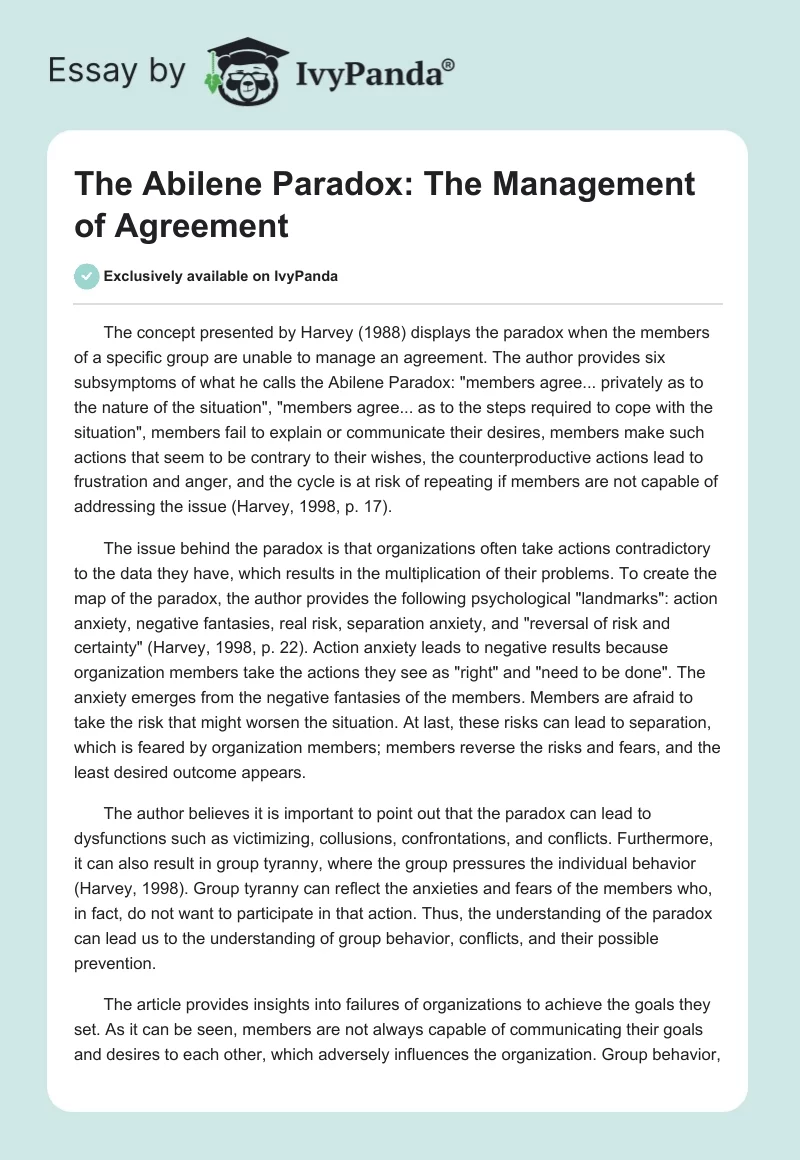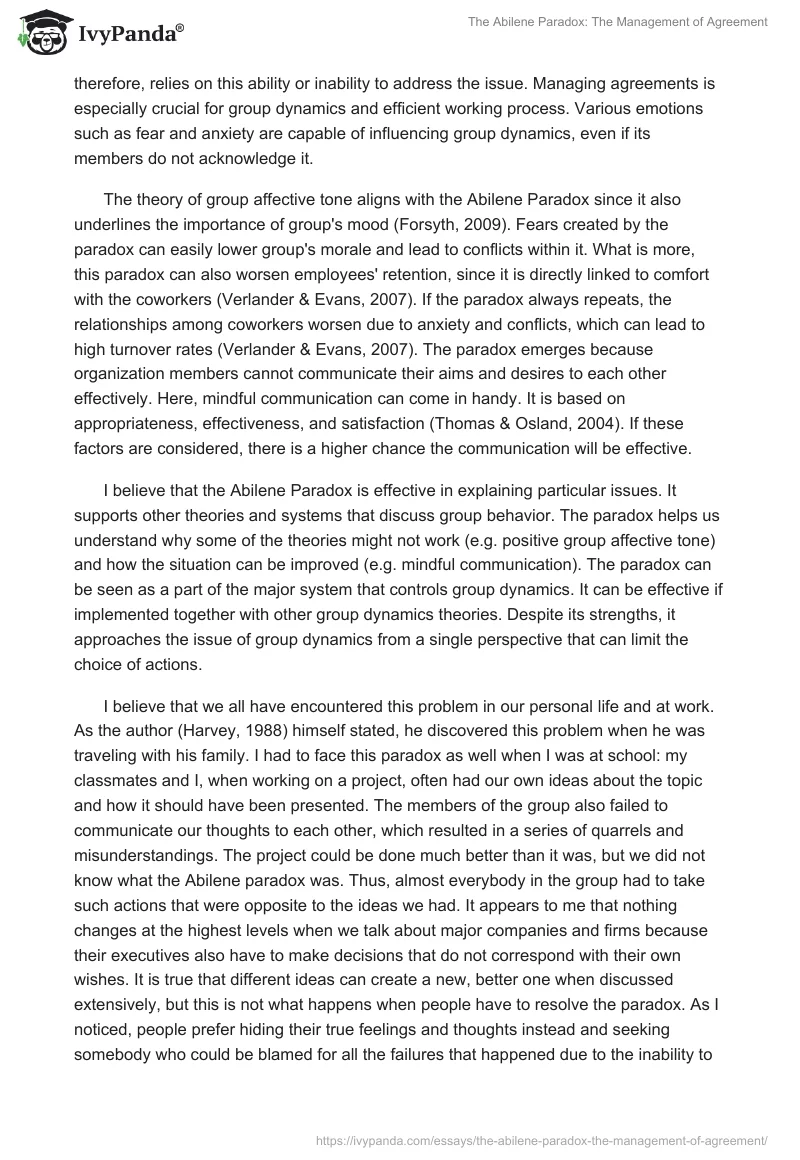The concept presented by Harvey (1988) displays the paradox when the members of a specific group are unable to manage an agreement. The author provides six subsymptoms of what he calls the Abilene Paradox: “members agree… privately as to the nature of the situation”, “members agree… as to the steps required to cope with the situation”, members fail to explain or communicate their desires, members make such actions that seem to be contrary to their wishes, the counterproductive actions lead to frustration and anger, and the cycle is at risk of repeating if members are not capable of addressing the issue (Harvey, 1998, p. 17).
The issue behind the paradox is that organizations often take actions contradictory to the data they have, which results in the multiplication of their problems. To create the map of the paradox, the author provides the following psychological “landmarks”: action anxiety, negative fantasies, real risk, separation anxiety, and “reversal of risk and certainty” (Harvey, 1998, p. 22). Action anxiety leads to negative results because organization members take the actions they see as “right” and “need to be done”. The anxiety emerges from the negative fantasies of the members. Members are afraid to take the risk that might worsen the situation. At last, these risks can lead to separation, which is feared by organization members; members reverse the risks and fears, and the least desired outcome appears.
The author believes it is important to point out that the paradox can lead to dysfunctions such as victimizing, collusions, confrontations, and conflicts. Furthermore, it can also result in group tyranny, where the group pressures the individual behavior (Harvey, 1998). Group tyranny can reflect the anxieties and fears of the members who, in fact, do not want to participate in that action. Thus, the understanding of the paradox can lead us to the understanding of group behavior, conflicts, and their possible prevention.
The article provides insights into failures of organizations to achieve the goals they set. As it can be seen, members are not always capable of communicating their goals and desires to each other, which adversely influences the organization. Group behavior, therefore, relies on this ability or inability to address the issue. Managing agreements is especially crucial for group dynamics and efficient working process. Various emotions such as fear and anxiety are capable of influencing group dynamics, even if its members do not acknowledge it.
The theory of group affective tone aligns with the Abilene Paradox since it also underlines the importance of group’s mood (Forsyth, 2009). Fears created by the paradox can easily lower group’s morale and lead to conflicts within it. What is more, this paradox can also worsen employees’ retention, since it is directly linked to comfort with the coworkers (Verlander & Evans, 2007). If the paradox always repeats, the relationships among coworkers worsen due to anxiety and conflicts, which can lead to high turnover rates (Verlander & Evans, 2007). The paradox emerges because organization members cannot communicate their aims and desires to each other effectively. Here, mindful communication can come in handy. It is based on appropriateness, effectiveness, and satisfaction (Thomas & Osland, 2004). If these factors are considered, there is a higher chance the communication will be effective.
I believe that the Abilene Paradox is effective in explaining particular issues. It supports other theories and systems that discuss group behavior. The paradox helps us understand why some of the theories might not work (e.g. positive group affective tone) and how the situation can be improved (e.g. mindful communication). The paradox can be seen as a part of the major system that controls group dynamics. It can be effective if implemented together with other group dynamics theories. Despite its strengths, it approaches the issue of group dynamics from a single perspective that can limit the choice of actions.
I believe that we all have encountered this problem in our personal life and at work. As the author (Harvey, 1988) himself stated, he discovered this problem when he was traveling with his family. I had to face this paradox as well when I was at school: my classmates and I, when working on a project, often had our own ideas about the topic and how it should have been presented. The members of the group also failed to communicate our thoughts to each other, which resulted in a series of quarrels and misunderstandings. The project could be done much better than it was, but we did not know what the Abilene paradox was. Thus, almost everybody in the group had to take such actions that were opposite to the ideas we had. It appears to me that nothing changes at the highest levels when we talk about major companies and firms because their executives also have to make decisions that do not correspond with their own wishes. It is true that different ideas can create a new, better one when discussed extensively, but this is not what happens when people have to resolve the paradox. As I noticed, people prefer hiding their true feelings and thoughts instead and seeking somebody who could be blamed for all the failures that happened due to the inability to manage the group. I also think this problem is crucial for schools where different teachers have different approaches towards teaching but prefer blaming the educational system/the school management instead of trying to cooperate. Thus, the paradox is common for organizations of all levels and needs to be addressed as soon as possible to avoid conflict and dissatisfaction.
References
Forsyth, D. R. (2009). Group dynamics (5th ed.). Boston: Cengage Learning.
Harvey, J. B. (1988). The Abilene paradox: The management of agreement. Organizational Dynamics, 17, 17-43.
Thomas, D. C., & Osland, J. S. (2004). Mindful communication. In H. Lane (Ed.), The Blackwell handbook of global management: A guide to managing complexity (pp. 94-108). Hoboken: Wiley-Blackwell.
Verlander, E. G., & Evans, M. R. (2007). Strategies for improving employee retention. Clinical Leadership & Management Review, 21, 4-12.


